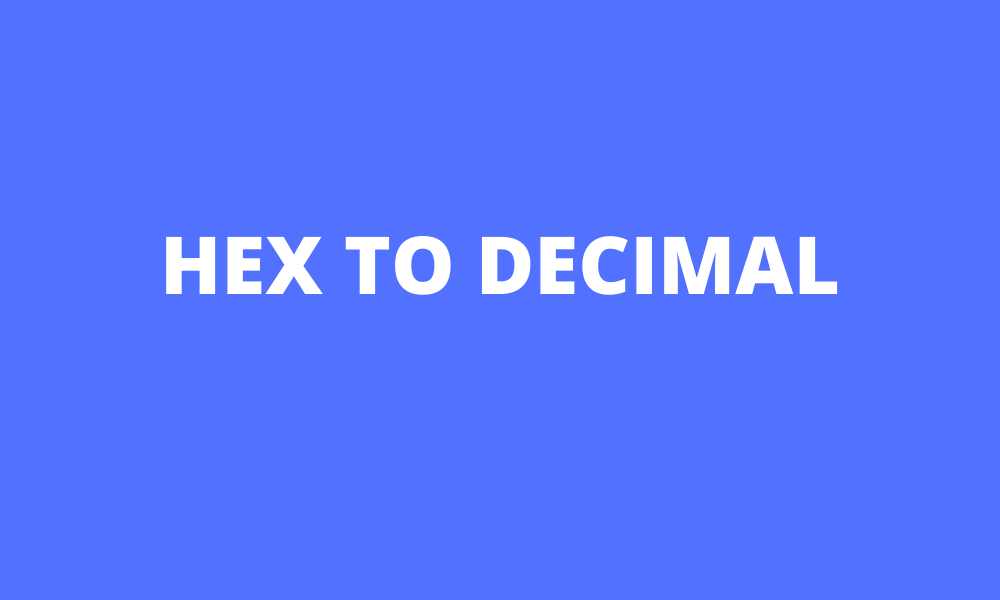HEX to Decimal: Converter For Most Popular System of Numbers
Hexadecimal, more commonly known as HEX code or HEX, is a way to represent binary data using text. This means that using HEX code we can turn a large amount of binary data into human readable ASCII characters. In other words, human readable form of hexadecimal values.

So, how about Decimal?
Decimal is a base 10 positional number system. It has ten digits {0, 1, 2, 3, 4, 5, 6, 7, 8 and 9} in it. Decimal computer numbering system is used for solving mathematical problems by a computer. It has values from +1 to -9.
Decimal system most commonly used in everyday life. We use decimal numbers every day and we do not realize it . Like store prices are written .999995 or $3.14159 etc .
In the electronic devices we see binary systems but when we input data (specially western union) decimal numbers are used.
The most widely recognized binary systems are binary stars, consisting of pairs of stars that are gravitationally bound and generally move much in the same way as regular stars in those systems.
Many visual binaries (e.g., Mizar) consist of two unrelated objects in close proximity, only appearing to be gravitationally bound when viewed from Earth.
By contrast, orbital binaries tend to be Tatooine-style systems, where two objects move significantly relative to each other as they orbit a common center of mass.
This list of numeral systems includes mathematical notations used in different parts of the world to represent numbers. Since not all civilizations developed their own notation, the significance is expressed where it can be easily understood.
For example, the 978 figure in Chinese numerals refers to the last digit being a nine hundred and seventy, while it means eight thousand on Hebrew and Arabic numerals.
The undecimal standard positional numeral system is a positional numeral system used to represent digital information, especially in computers.
The system was proposed for use in new systems by IBM in 1966, and it attracted wide attention after it was selected for the design of the American Standard for communication equipment and computer facilities.
The quinary numeral system, or base-5 numeral system, is the most common of the systems of denoting integers (or whole numbers) using two numerals, typically the digits 0–4.
In a quinary place system, five numerals can represent all the integers from 0 to 4 − 1. Methods for counting using quinary have been devised independently in many cultures around the world.
A ternary numeral system (sometimes called a triteral numeral system) is a base-3 numeral system that has multiple representations.
While base-3 systems are rare, they have been proposed as an alternative to the binary number system (0 and 1) and the decimal number system (which is base 10).
Ternary systems can be useful for encryption schemes.
Babylonian numerals are a special numeric system that was developed around 1750 BC and used by the ancient Babylonian people and throughout the Babylonian Dynasty until around 50 BC.
Several different writing systems were used to represent the Babylonian numerals, though scholars believe that the sexagesimal positional notation of the Sumerians was by far the most widespread and widely understood convention.
It is believed that when they needed to record large numbers they used their sexagesimal system and converted them into our modern notation as we think of it today as Arabic numerals. The Babylonians made an important contribution to mathematics by replacing the base ten place value system with a base sixty system. This had many advantages and helped to make it easier for them to solve mathematical problems.
Aegean numerals are a numeral system used in Aegean civilization in the Late Bronze Age.
Also called Old-Greek numerals, this numeral system was used by Greek inhabitants of the Aegean basin as early as the second millennium BCE.
The term "Aegean numerals" was coined by Arthur Evans in 1903 based on the archaeological finding at the ruins of the ancient site of Minoa, near Knossos on Crete.
Aegean numbers is a numeral system used by the Minoan and Mycenaean civilizations. It consists of two different sets of symbols: one for the odd numbers (1, 3, 5, 7) and one for the evens (2, 4, 6). The first column shows the odd-numbered signs, the second column shows their corresponding values. The sum of any two numbers can be obtained by adding their digits pairwise. For example: + = 3+2 = 4 = 512 = 32 = 11.
Most of us use 1 2 3…numerals every single day. Our ability to perform basic arithmetic is one of the things that makes us uniquely human – well, that and language.
When it comes to writing numbers, however, there are a few different numeral systems in existence. Today, I want to focus on discussing what is known as “Eastern Arabic numerals”, also referred to as “Arabic numerals” or “Indian numerals”.
These numerals were spread throughout the world during the 1000s by merchants and explorers from the Middle East and India until they became the default numeral system used for commerce in Europe today.
For more tools like hex to decimal, please visit the tool page.